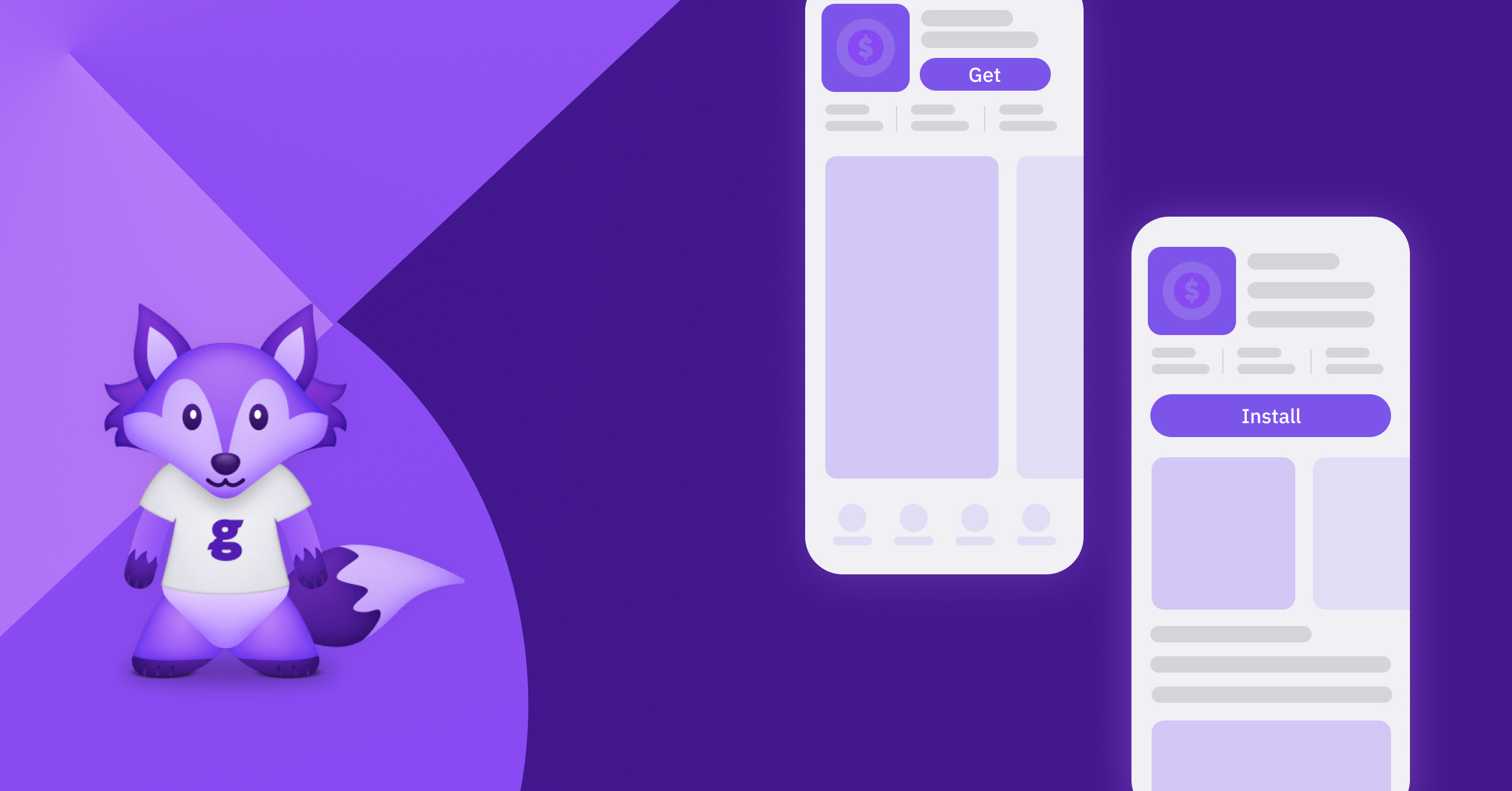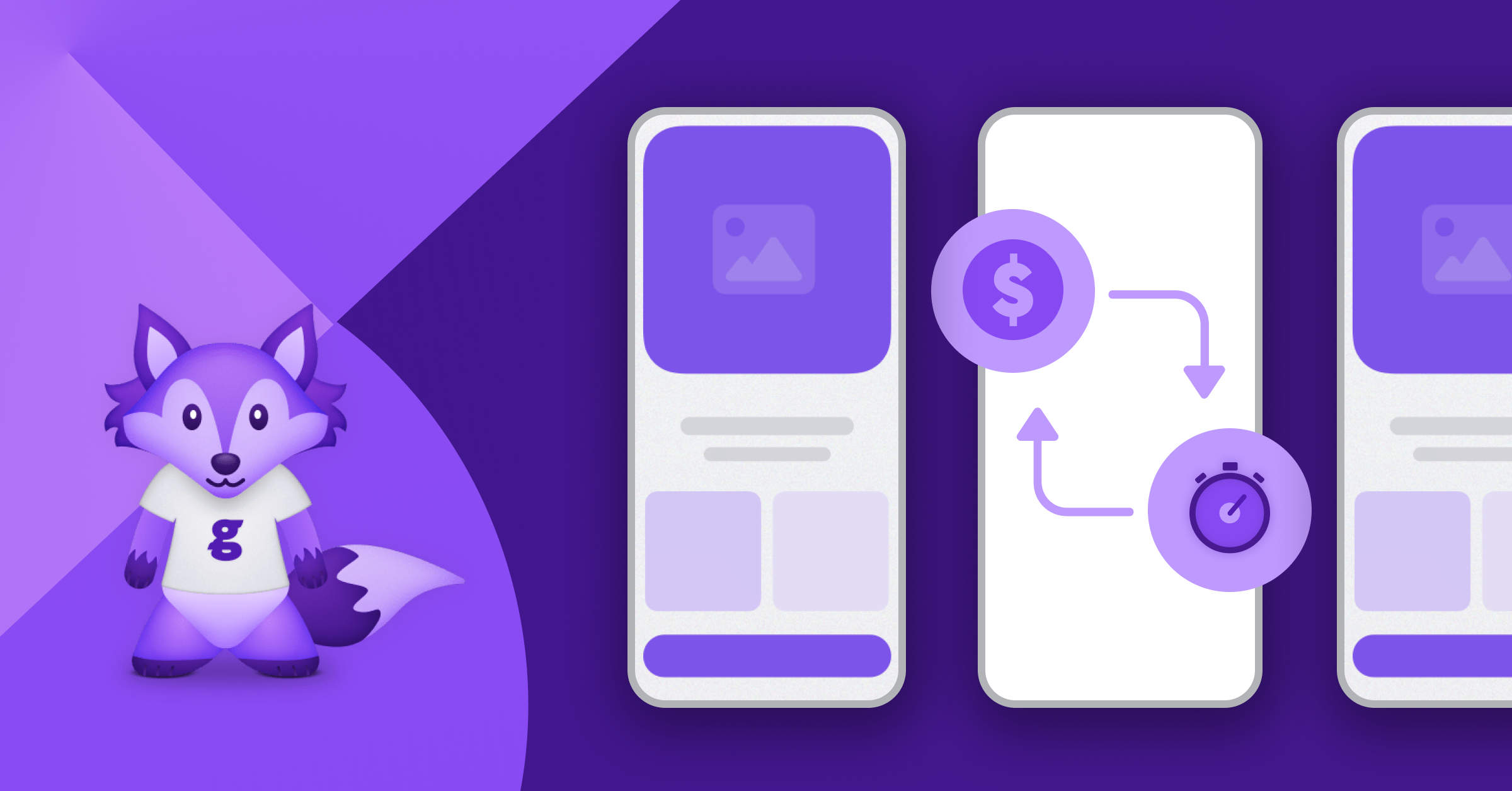Content
How to Monetize a Subscription-Based App in 6 Easy Steps [Free Ebook Included]
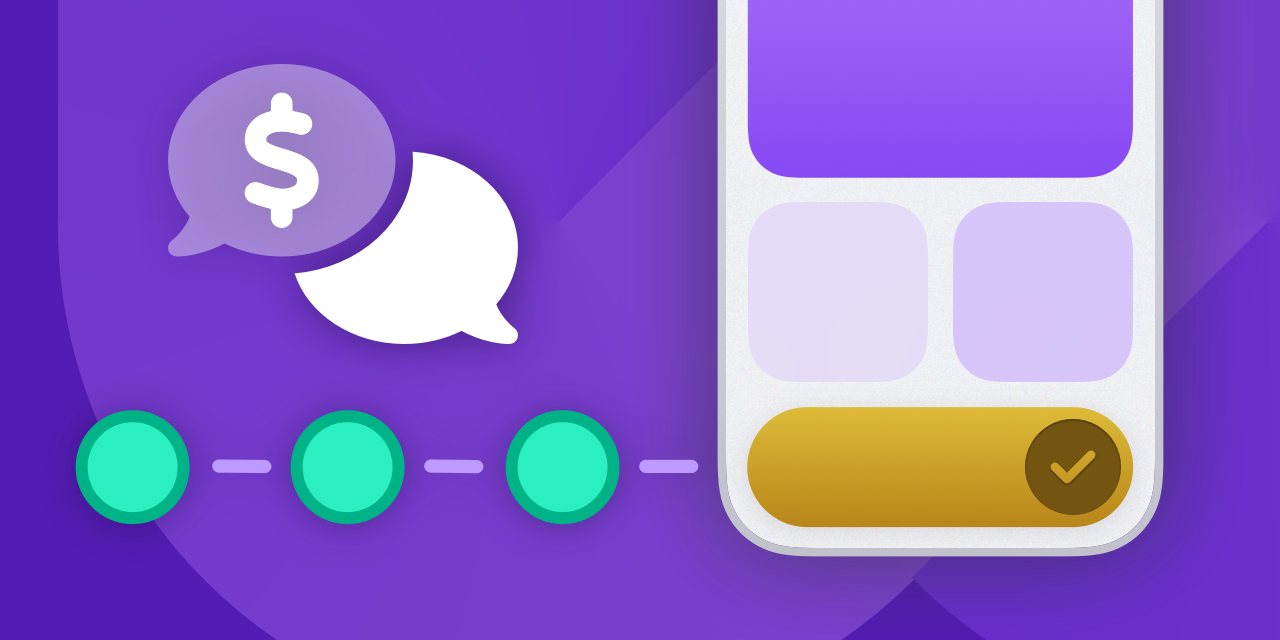
A strategy is a summary of everything you plan to achieve and a step-by-step roadmap to gauge the success of your app subscriptions. The more specific your plan is, the more effective it will be. Make your plan clear and easy to measure. Avoid vague, unattainable goals.
In this post, we’ll walk you through a six-step plan to create a winning strategy of your own. We’ve even got expert insights from Robbie Baxter (Strava, Survey Monkey, and more), Mayank Gupta (SwiftAnytime), Steve Young (App Masters), Vahe Baghdasaryan (Growth Mentor), Karan Tibdewal (CRM Guy), Lexi Sydow (data.ai and more)
Why companies should consider a subscription based model
- Predictable revenue Subscriptions provide a steady and predictable stream of income for companies, allowing more accurate financial planning and forecasting.
- Increased customer retention Subscribers commit to using a company’s product or service for a defined subscription period, which can lead to higher customer retention rates compared to one-time purchases. This reduces the need for constant customer acquisition efforts.
- Reduced churn Users subscribe to a particular company’s offer for a set time period—like a month or a year—and are therefore less likely to switch to a competitor’s offer during that time period, giving the company more time to convince the customer to stay.
- Increased customer lifetime value Subscribers usually have a higher customer lifetime value than one-time purchasers because they generate recurring revenue.
- Reach more customers Tiered pricing means companies can reach a range of customers with a range of needs—and also add additional pricing tiers as and when needed. One-off pricing, on the other hand, would appeal to a small subset of customers.
- Forge long-term relationships with customers Subscriptions give companies the chance to develop long-lasting relationships with their existing users. They can gather feedback and feature suggestions, and leverage this information to provide a better service, further increasing retention and customer LTV.
Why customers like subscription models
- Lower up-front costs By nature, subscriptions are cheaper than buying the product, content or service up-front. Subscriptions make products accessible to those who wouldn’t be able to afford a one-off $500 payment for a software or online tool, and makes it easier for companies to spread the cost.
- Predictable on-going costs Subscriptions make it easier for customers to budget recurring payments, because they know exactly how much will be taken out of their account each month, and on which date. In-app purchases for instance are a great app monetization model but they lack the predictability.
- An ever-evolving product When you sign up to Netflix, Masterclass or Amazon Prime, you’re not just accessing the content that’s already there—you’re immediately gaining access to any content that’s added while you’re still a subscriber. This is an additional incentive for customers to stay subscribed, which in turn benefits the company.
- Better customer service Companies that offer a subscription service are more inclined to provide top-tier customer support than companies with one-off purchases. This in turn benefits the customer, who knows their questions and concerns will be answered promptly, allowing them to get the most out of their subscription.
- The chance to test a product or service When you’re buying something as a one-off purchase, there’s often no return policy when it comes to apps or software. With app subscriptions on the other hand, customers can ascertain whether it’s something that really adds value to their life before committing.
- Access to premium features If the app offers a free option, a premium version comes with a sense of exclusivity and prestige, beyond the access to the premium features themselves.

(source: Statista)
Step 1. Before Starting Your Subscription-Based App

(source: Subscription App Playbook)
The subscription landscape has changed
In 2023, subscriptions are nothing new. We subscribe to news apps, music apps, streaming apps, games apps, marketing software, email software, health tracking apps, and everything in between. So how did we get to this point?
Let’s rewind to August 1997, when what is now one of the world’s most popular subscriptions was founded. Netflix didn’t begin its life as an app—in fact, their subscription apps were only launched in 2010, when the company had already been around a full 13 years.
At the same time, you’ve got the one-off apps: the note-taking app, the scanner app, the photo editing app. You’d buy it once, let’s say for $3, or $8, or $20, and then it was yours forever. With the boom of Gaming apps many moved to a In-App Purchases model. It is often utilised by Gaming apps, creating an enticing user experience that encourages users to make small consumable app purchases, for in-game enhancements and progress.
By this point, customers are very comfortable with the subscription model. There’s a high level of trust, and in the entertainment and media industry alone, the average American has 12 subscriptions. And on the company side, subscriptions offer a lot of benefits, too.
3 questions to ask before starting subscription apps
If your company is looking to monetize its app through a subscription service, start by asking these three questions.
- Are people willing to pay for a subscription?
- Are people used to owning what you’re offering outright?
- What are people used to subscribing to already?
If you can say “Yes” to all of these questions, you are in a good spot to start a subscription based app.
3 Common Pitfalls to Avoid
- Not thinking through the whole members’ journey
- Over-indexing on acquisition benefits & ignoring engagement benefits
- Bundling mismatched products
Step 2. Building the Right Tech-Stack For Your Subscription App
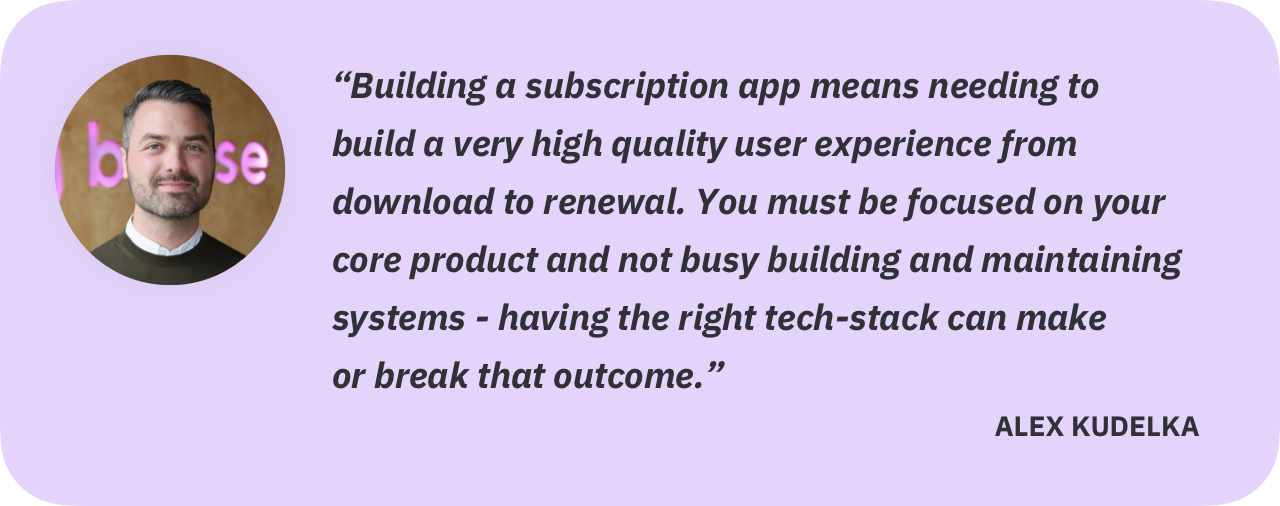
(source: Subscription App Playbook)
Tech stack offers are changing all the time—which means that often, when an app is first built, especially if that’s 5, 10 or 15 years ago, chances are they were using their own proprietary technology. It’s a lot of effort to start over buying in their tech stack, but for subscription apps looking to professionalize, it’s worth considering. When deciding what to buy off the shelf and customize and configure, it’s important to choose wisely.
As one of our experts, Robbie Kellman Baxter points out, “often, companies over-promise and under-deliver. They say they’ll be your subscription billing engine, and that they can do everything. But the reality, as people who use their product will know, is that they’re often great at doing something, but not everything.
Let’s walk through a quick guide to potentially help you figure out if you should build or buy. First, stop and say to yourself:
“Just because you have bandwidth doesn’t mean you should build”
Run yourself through this exercise to see if it makes sense to build it yourself:
- Do you have the budget to maintain the resources to scale what you build?
- Are you competing with the market to release this functionality you want to implement?
- Do you actually have the expertise in-house to build an appropriate solution?
- Is the technology you are building part of your unique selling point?
Step 3. How to Price Your Subscription App
So you’ve decided to launch your subscription app. You’ve got your tech-stack in place, you’ve done your initial market research, and you’re thinking about launching in the near future. What’s next? Establishing the pricing of your subscription is one of the most critical parts of the process. It’s not as simple as choosing a price and running with it—to ensure success, you need to take your time conducting research and doing the requisite due diligence to establish your pricing tiers.
The best way of figuring out the optimum pricing for your app? Testing out various options. Check out what competitors are charging to determine a ballpark range, and pick a few pricing options to test.
Next take a look at some of the pricing approaches you might choose to take.
Competitive Pricing: Pricing products in alignment with or just below your competitors’ prices in order to tempt customers to your mobile app subscription, instead.
Cost-Based Pricing: Setting prices by adding a profit margin to the cost of producing your app.
Comparative Pricing: Setting two different prices alongside each other to make one appear cheaper, and thus more appealing to the customer.
Value-Based Pricing: Setting prices based on the perceived value and benefits that your app provides to customers.
Penetration Pricing: Setting low prices at the start in order to quickly enter the market and gain a customer base for your app.
Dynamic Pricing: Adjusting prices in real-time based on factors including demand, supply, external factors and customer behavior.
Bundle Pricing: Setting one price for multiple products, tools or software bundled together that’s lower than if each were purchased separately.
Psychological Pricing: Setting prices that speak to consumers’ psychological perceptions, like ending prices in .99 or .95 to make them appear lower than if they were rounded up.
Premium Pricing: Setting high prices to create a perception of luxury or exclusivity for your app.
Step 4. Paywall Best Practices to Maximize App Monetization

(source: Subscription App Playbook)
At its most basic, a paywall is a digital barrier that restricts access to certain online content, tools, services or features. It requires users to subscribe in order to access the content behind the paywall.
Kinds of paywalls to consider for subscription apps
Hard Paywall: This type of paywall completely blocks access to the app unless the user has a subscription.
Soft Paywall: A soft paywall allows users to access a limited portion of the app for free, but restricts access to premium or features, content or tools that require a subscription.
Metered Paywall: With a metered paywall, users are allowed to access a certain number of articles, tools or minutes (for transcription or video editing, for example) free within a specified time period, like a month or week. Once they’ve exceeded the limit, they need to subscribe for continued access.
Freemium: In this model, basic features or tools are provided for free, but premium or exclusive features require a subscription or payment.
Partial Paywall: Some paywalls restrict access to a section of an article or app, enticing users to subscribe to read the full content, or to access the full range of features.
The anatomy of a (subscription based app) paywall
- Lead with the main benefit
- Pricing table above the fold
- ‘Subscribe now’ or ‘start free trial’ in a floating button
- Lead with three or four key benefits.
- Social proof
- Features table
- Testimonials
- Pricing table again
- FAQs
Trial or no trial?
It’s an issue that divides: should your app offer a trial version or not? In short, it depends on the app subscriptions you’re offering. Steve Young recommends having a trial during your onboarding paywall. However, once a user has decided not to activate a trial and has started using your app, consider removing the trial. If you decide to do this, you’ll need 2 subscription plans, for example: one yearly with a trial and one yearly without a trial.
Step 5. Strengthening App Monetization with CRM

(source: Subscription App Playbook)
Mobile CRM is typically a trojan horse for your subscription model. Investing in CRM tools & strategy early on can help subscription apps improve their funnel metrics quickly & oftentimes drastically. There is a lot of business impact that can be driven through utilizing some key CRM channels such as push notifications, email as well as in-app messaging.
CRM for subscription apps framework
If you’re an app starting out, a CRM can have a lot of best practices that are confusing to navigate. For subscription apps, however, there are 3 layers of CRM sophistication that exist.
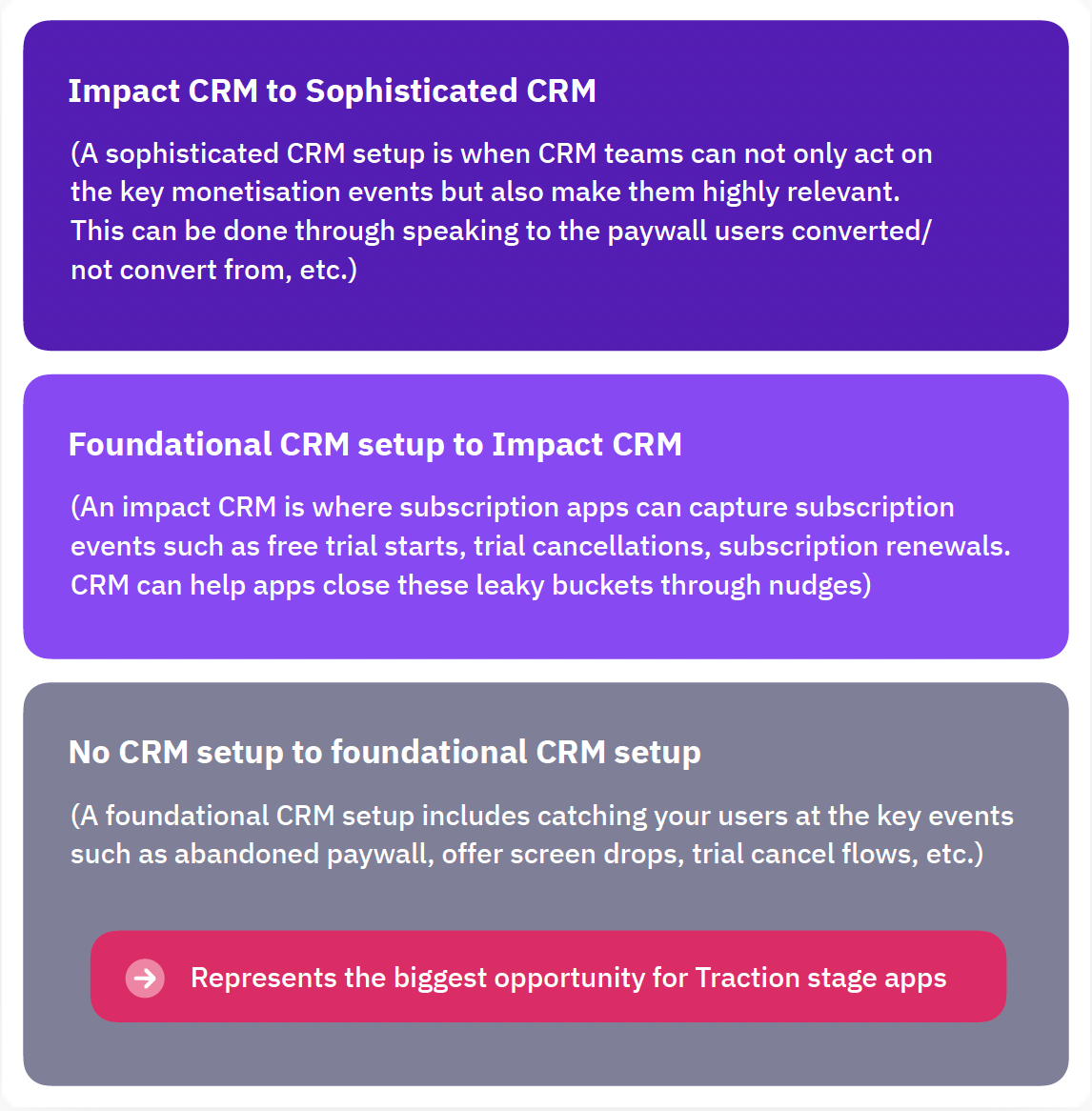
(source: Subscription App Playbook)
The biggest impact comes when you go from zero to one by implementing the foundational CRM.
If you are a subscription app, you want to reach most of your app users through CRM channels, and trigger relevant notifications to your users at the right time. In terms of what that means practically for app developers is to be able to stream some key monetization funnel data to your CRM tool of choice. Refer to the cheatsheet below to get some quick win ideas.
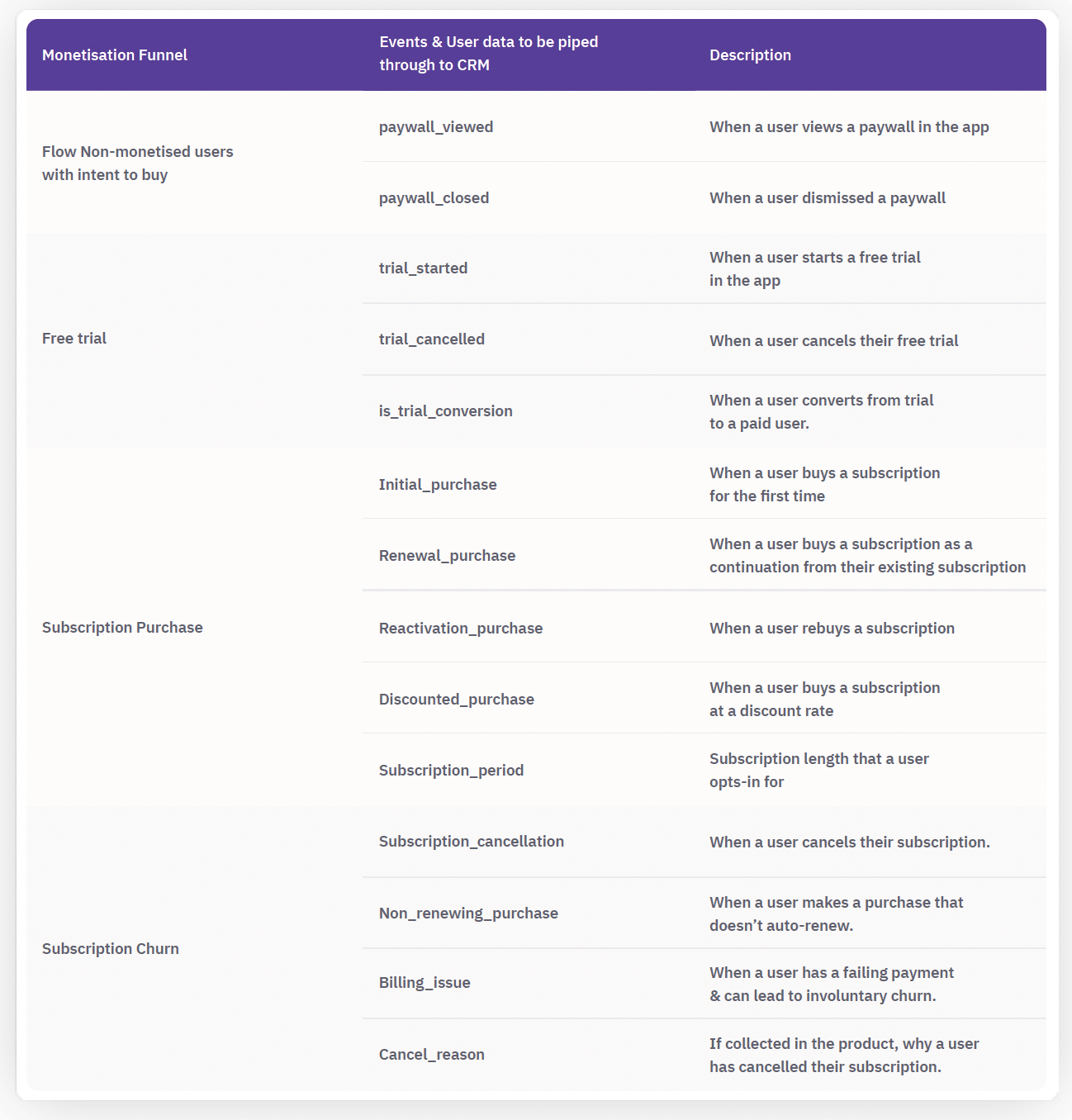
(source: Subscription App Playbook)
Step 6. Analyse the Success of Your Subscription Model

(source: Subscription App Playbook)
you’ve set up your tech-stack, optimized your paywall, picked your pricing, and you’ve got your CRM sorted. What’s next? Metrics and analysis. Tracking the right metrics will ensure your app sees success over time, and will allow you to adjust for issues as they arise. Staying on top of your numbers is critical for staying one step ahead of competitors, and making sure you’re able to accurately benchmark your subscription based app.
Choosing a primary category for your subscription based app
It all starts with the categories your app sits under in the App Store. Why is this so crucial? Because on the one hand if you pick the wrong category, you might not be seen by the right people on the App Store, but also you will benchmark your metrics against a wrong category.
Let’s say you have a photo-sharing social networking app. For the App Store, you could choose either Photo & Video or Social Networking as your primary category. To decide which category will best serve your app, consider the following:
- Your app’s purpose. Your primary category should be the one that best describes the main function or subject matter of your app.
- Where users naturally look for an app like yours. Understanding your audience will help you identify the category in which they will likely look for your app. Will they consider your app to be more of a social network app or a photography app?
- Which categories contain the same type of apps as yours. Research how similar apps are categorized — app users may already know to visit these categories to find this type of app.”
The top three metrics subscription apps should be thinking about
Overwhelmed by the wealth of insights you can track for your app? Lexi Sydow from data.ai breaks down the most important metrics you should be thinking about.
- Downloads
- Active users
- Revenue
Conclusion
There you have it, a subscription apps strategy in 6 easy steps.
Now, it’s time to turn everything you’ve learned into action.
Read More
